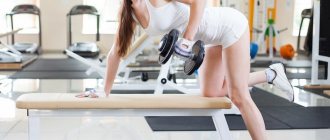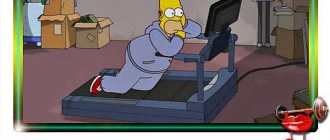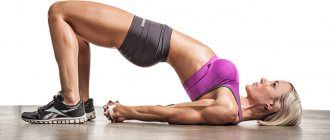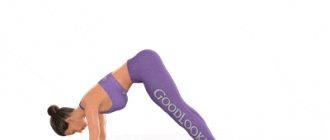Warm-up in the gym: exercises for all parts of the body
As we have already said, there is no specific program that suits everyone. Warm-up in the gym for men and women may differ depending on the characteristics of the body and your goals. However, there are exercises for each body part that are suitable for almost everyone and can be used as a warm-up before a general workout.
So, a warm-up in the gym for girls and men, aimed at working out the neck muscles, may include the following exercises:
- Bend the neck to the sides, forward and backward - three times.
- Circular movements of the neck in different directions - three times.
- Turn the head left and right - three times.
To work the wrists and shoulders:
- Roll your shoulders back and forth – ten times.
- Circular movements with your elbows alternately in both directions - ten times.
- Circular movements of the wrists with hands clenched into fists - ten times.
For the core, a general warm-up before training in the gym for men and women might look like this:
- Bends the torso forward and backward. In this case, the pelvis should be fixed in place, hands should be placed on the hips - 3-4 times.
- Circular movements of the body alternately in both directions, while keeping the pelvis in place - 3-4 times.
- Hold your pelvis in the same way, twist your body to the left, then to the right - 3-4 times.
- Keep your legs straight, shoulder-width apart, spread your arms to the sides, bend and twist. Use the fingers of your right hand to touch the toe of your left foot and vice versa. At the same time, hold your other hand straight behind your back - 3-4 times.
Exercises for chest muscles:
- Place your hands behind your back in a lock. Keep them straight, pulling upward to feel the pectoral muscles stretch - hold this position for five seconds.
- Grasp any vertical support with your hand. Then lean your body to the side, twist a little and hang on a straight arm for five seconds. Do the same with the second hand.
Warm-up for back muscles:
- Grasp the vertical support with your hand, now pull your pelvis back and stretch your back. Do the same with the other hand - hold for five seconds.
- Lean slightly forward and to the side, extend one arm to the other, then switch arms and sides. Hold for five seconds. At the same time, you need to feel how your back is stretched.
To work your obliques, do 3-4 repetitions of side bends. For the back of your legs, bend down, bringing your straight legs together and trying to reach your toes. Hold in the lower position for a few seconds.
It is important to stretch your knees - this will not only help prepare them for stress, but also minimize injury. Use the following exercises:
- Bring your feet together. Sit down a little, place your hands slightly above your knees, now make circular movements in both directions alternately. Keep your knees together. Repeat the exercise 8-10 times in each direction.
- Place your feet shoulder-width apart and your hands should be slightly above your knees. Make circular movements with your knees inwards, then with both legs simultaneously to the sides - repeat 8-10 times.
- With your feet shoulder-width apart, perform 15-20 squats.
To work your quadriceps, take a standing position with your knees together. Bend one leg at the knee, grab your back with one hand, pull your heel towards your buttock. You can hold onto the support with your other hand.
To work your shins, make circular movements with them in both directions 7-10 times.
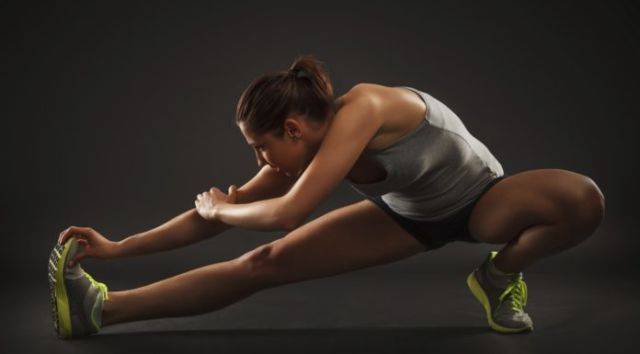
It is important to warm up with stretching in the gym, aimed at stretching the legs and perineum. To do this, make a wide lunge forward with one leg, pull the other leg back, sagging your pelvis down. Bend your front knee at a right angle, place your hands on both sides of the foot of the leg that is in front. The heel of the back leg should touch the floor. Lock in this position for 3-5 seconds. Then straighten the knee of your front leg, pull your body down, and then bend it back. The knee needs to be bent and straightened. Repeat 5 times for each leg.
It is important to know how long the warm-up and cool-down should last in the gym. The answer is no more than 15 minutes, since then the body will get tired and may not have enough strength for further training
Ideal regimen: 5-7 minutes for cardio, and 5-7 minutes for general warm-up.
By devoting just 10-15 minutes to preparing your body and muscles before class, you can significantly increase its effectiveness. Warming up before training in the gym, videos of which can offer good options for doing it, is an integral part of physical activity and an important guarantee of its safety.
Proper three-step warm-up
How to do a warm-up, properly warm up your muscles and not get tired before the main workout begins? Let's take it in order.
Types of warm-ups
We can put it another way and replace “types” with stages. Because first, a general warm-up is done, and then, as the workout progresses, a warm-up is done for all muscle groups that will be loaded.
A general warm-up includes cardio and joint exercise. And warming up for specific muscle groups means working without weights or with light weights before specific exercises.
Let us now clarify how to warm up correctly and what set of exercises can be used for warming up.
Cardio - the first stage
A proper pre-workout warm-up begins with cardio.
You need to devote 5 to 20 minutes to running, an exercise bike, or an elliptical machine. You can combine exercise machines with jumping rope or other high-intensity cardio exercises.
- Fitness warm-up before weight training should be minimally energy-intensive. That is, the intense cardio part should be completed in 5–7 minutes.
- But if your goal is to lose weight, you need to run or jump longer - at least 20 minutes.
So, your pulse has risen, blood circulation has activated, the blood quickly carries oxygen and other necessary substances throughout the body.
Next, the question arises of how to warm up the muscles and joints to reduce the likelihood of injury. Let's look at the basic exercises for warming up before training.
Joints - second stage
Circular movements with different parts of the body help warm up your joints before training:
- Gently rotate your head. First, make 10 circular movements clockwise, then the same number counterclockwise. With each movement, try to increase the diameter of the circle being described.
- Pull your chin towards your chest, tilt your head as far as possible to the right and left. Repeat this movement several times.
- Place your fingers on your shoulder joints and roll your shoulders. Do these rotational movements with your arms in both directions 10 times each. Circular movements are made simultaneously with both arms bent at the elbows.
- Now you need to describe the circle several times with one and the other hand, turning your arm at the elbow.
- Then we do the same, rotating the hands at the wrists. Clench and unclench your fingers several times.
- Next, we make circular movements with the upper part of the body while standing on our feet.
- We fix the body and make circular movements with our hips, placing our hands on the belt.
- Now you can swing your legs forward and backward 10 times or squat 10 times at a pace.
- Raise your knee so that your thigh is parallel to the floor, and point your toes down. You need to draw a circle with your toe above the floor using movement in the knee joint.
- Place your toe on the floor and make rotational movements with your ankle.
Thus, we worked through all the joints sequentially from top to bottom.
There are other exercises to warm up your joints before exercise. They are done in exactly the same way, but your task will be to draw the number 8 instead of a circle. This warm-up is used in various schools of hand-to-hand combat. The effectiveness of this warm-up scheme lies in the fact that such a trajectory of movement warms up the joint much better than just a circular one.
Indeed, if you analyze this diagram, then in one exercise you perform several simple movements at once. For example, when tracing the number 8 with your head, you move your head forward, backward, right, and left. There are also circular trajectories.
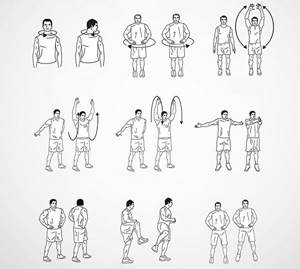
How to conduct such a warm-up is exactly the same as a regular circular one. This is a very interesting way to prepare the body for training.
Warm-up at home is carried out in the same two ways: in a circle and in the figure 8.
Warm-up before training can take place in the form of outdoor active games, if we are talking about a children's sports section.
In martial arts schools, they conduct a warm-up to strengthen the body's strength and coordination resources. Such preparation allows you to warm up your muscles before training and prepare your body for good coordination.
How to make training safe? Do a basic warm-up!
Why do you need to warm up before training?
The main task of warming up is considered to be preparing the muscles for subsequent loads, although in fact its functions are much broader. This is the initial stage of any training and is considered necessary. It prepares the muscles and central nervous system for stress. Moreover, warm-up is necessary even in everyday life, before doing physical work.
If we highlight the main reasons for which it is worth warming up the muscles, we should note:
- Prevention of injuries - “cold” muscles are much more easily injured, therefore, without pre-warming, the risks of sprains, dislocations and even muscle rupture increase significantly;
- Accelerating muscle recovery after training and reducing soreness;
- Preparing the central nervous system for physical work;
- Improving blood circulation;
- Stimulation of hormone production.
It is important to understand that the body can instantly start working only in extreme situations, when there is a huge release of hormones. However, this is a colossal stress, after which there is a strong decline in activity
In sports, the degree of load should be increased gradually, from regular gymnastics or cardio to performing specialized exercises with light weights. Only after this can you begin full-fledged training and take on working weights.
It is also important to learn how to correctly distinguish between types of warm-ups. Their overall effectiveness will depend on this
Usually there are 3 types:
- Cardio (treadmill running, orbitrek, exercise bike, etc.);
- Dynamic;
- Static.
Cardio exercises warm up the muscles well and prepare the body for physical work, but they require more time. Usually lasts from 10-12 minutes. The downside of cardio is that unprepared athletes can lose a lot of energy even before the main workout begins.

The dynamic type includes two subtypes: gymnastic movements (swings, turns, squats, jumps, etc.) and profile exercises. For example, if you come to train your chest (in weightlifting, powerlifting or regular fitness), and the first exercise is the bench press, then before using working weights you should perform 2-4 warm-up approaches, with the weight of the bar gradually increasing, from an empty bar to 50 % of the one-time maximum. Regardless of the type of sport and the inclusion of cardio before class, dynamic movements are always performed.
The static type includes various types of stretching. According to research, this type of stretching is not recommended before exercise. This not only impairs the effectiveness of the training, but also increases the risk of injuring the joints (due to overly stretched muscles). For static movements to be useful, they are performed at the end of the lesson, also often called a “cool down”. In this case, stretching will not only reduce pain, but also accelerate muscle recovery due to increased utilization of lactic acid.
To warm up your muscles correctly, you should remember the basic rules:
Movements should not be too fast or hasty
Do the exercises at a moderate pace; Sports doctors recommend adhering to the “top-down” principle, moving from the neck to the feet; You need to warm up all muscle areas that will be involved during the exercises; When warming up the muscles, it is necessary to pay attention to each joint; Time for dynamic movements is 4-5 minutes. Cardio - 10 to 15 minutes, no more.
CrossFit warm-up rules
There are several simple rules that should be followed to ensure that warming up before CrossFit benefits the athlete and does not harm them:
- Before training, you should carry out 3 types of warm-up - general (cardio), joint and functional. First you need to prepare your heart for work and increase your pulse; for this you do a little aerobic work. A joint warm-up allows you to increase joint mobility, elasticity of ligaments and tendons, and a functional warm-up helps prepare the muscles that you will train for work.
- When warming up, focus on those muscle groups that you will use during training. For example, if you plan to work your buttocks and legs, it is not practical to do 50 warm-up triceps push-ups.
- The best warm-up completely mimics the exercises you are going to do in your main workout, only using lighter weights or no weight at all (if we are talking about strength complexes). If, for example, you plan to run during a lesson, then after warming up your joints, run a little on the spot to warm up and stretch.
- Don’t turn your warm-up into a separate training session. This is fundamentally wrong, especially for a beginner. It is not at all necessary to warm up for forty minutes to achieve a positive result. You can effectively warm up your muscles in just a few minutes. A couple of exercises will be enough to prepare the body for real stress.
Cardio exercises to warm up muscles before exercise
Special elements are needed to increase blood circulation, increase body temperature, and prepare muscle fibers for stretching. The entire approach takes 1–2 minutes, one exercise is performed from half a minute to 45 seconds - actively, at a fast pace. The complex looks like this:
- Walking with knees raised. Bend your arms. Take deep steps in place, touching your knees to your elbows each time.
- Stand straight with your hands at your waist. Lunge to the side with your left leg while simultaneously raising your arm and bending slightly at the waist. Repeat for the right side.
- Finish your warm-up with an intense run in place.
The second block of cardio exercises is performed after stretching and takes 2–3 minutes. Elements are performed for 40–60 seconds at a fast pace. Procedure:
- Run in place.
- Jumping rope (you can imitate them without sports equipment).
- Energetic jumping. Once - spread your legs to the sides, raise your arms above your head and clap. Two - feet together, arms along the body.
- Run in place, raising your knee to waist level.
Joint warm-up
Gymnastics to activate the work of tendons, joints, ligaments, and improve their mobility will help to work the periarticular muscles. Each exercise is repeated 10 times (if necessary, 5 times for each side):
- Stand straight, feet slightly wider than shoulder-width apart, hands on your waist. Rotate your head along the trajectory left-down-right and in the opposite direction, without throwing it back.
- Stand straight with your feet shoulder-width apart. Make 5 circular rotations with your shoulders forward and backward.
- Make energetic turns of your head left and right.
- Standing straight, spread your arms to the sides. Bend your elbows. Make 5 rotations towards yourself and 5 away from you.
- Place your feet wider than your shoulders. Spread your arms to the sides and do 5 rotations forward and backward.
- Clasp your hands in front of you. Rotate your wrists, alternately bringing your left and right hand up.
- Feet wider than shoulder width, hands on waist. Rotate your pelvis clockwise, then in the opposite direction.
- Stand straight, feet together, hands on your waist. Raise your left leg bent at the knee, take it back and place it on the floor. 5 reps on each side.
- Stand up straight. Rotate your knees clockwise and counterclockwise, placing your palms on them and bending them slightly.
- Stand straight with your hands at your waist. Lift your left foot off the floor and rotate clockwise and counterclockwise. Repeat with the other leg.

Warm-up stretching exercises
These are elements to give elasticity to muscles. A set of exercises for warming up (perform 15–20 seconds each):
- Place your feet shoulder-width apart. Bring your arms back to your sides, then cross them in front of you.
- Stand up straight. With your left hand, grab your right hand at the shoulder and pull it towards you. Repeat for the other side.
- Stretch your triceps. Raise your arms above your head. Bend them at the elbows and bring them back. With your right hand, pull your left (just below the elbow) and vice versa.
- Stand straight with your feet wider than shoulder-width apart. Perform tilts left and right. Stretch together with your arm straight.
- Place your feet slightly wider than shoulder-width apart and spread your arms out to the sides. Make a "mill". Bend over, touching your left palm to your right foot and vice versa.
- Place your feet shoulder-width apart and place your hands on your knees. Squat down deeply. Slowly return to the starting position, arching your back strongly.
- Spread your legs wide. Place your palms on your knees and do a light squat. Bend over, turning your left shoulder toward your right knee. Repeat on the other side.
- Stand up straight. Lunge backwards with your left and right legs alternately. At the same time, place your knee on the floor and clasp your hands in front of you.
- Lunge back with your left leg straight. Place your palm on the floor near your supporting foot. Turn your torso and raise your right arm up. Repeat on the other side.
- Place your left foot in front of you on your heel. Bend your right knee. At the same time, move your hand backwards in a circular motion and touch your left toes with your toes. Return to the starting position. Repeat on the other side.
- With your right hand, hold on to some support (chair, edge of a table, machine). Bend your left leg back and catch it with your hand. Using springing movements, pull your foot towards your buttock. Repeat on the other side.

How to end your warm-up
The last stage of warming up is restoring breathing. Completes in 1–1.5 minutes. Choose one of these exercises:
- Inhale – pull your arms up through extension to the sides. Exhale – lower your arms and do a light squat.
- Inhale – raise your arms up to your sides. Exhale – bend forward with straight legs.
Warm-up before training at home for girls
If you vigorously warm up your body and all your muscles, you will fully prepare yourself for the subsequent load. As you can guess, you will be less tired and, accordingly, you will be able to do more approaches and a longer workout, which will ultimately lead you to getting results. How does this warm-up exercise work?

Photo from the site sunny7.ua
All these exercises should increase your heart rate, increase blood flow through muscle tissue and, very importantly, in order for your joints to withstand the load without problems, joint lubrication must be released, which will not allow them to overstrain. All this together will help you protect your body from unexpected injuries.
Well, now let's talk more specifically.
Warm-up as part of the training process.
Many people taking their first steps towards a healthy body have heard about the concept of warming up. But very often, for one reason or another, this very important part of the training process is somehow missed.
Let's talk today about the most important criterion , so to speak, for injury prevention and performance improvement - warm-up .
What is hidden under this interesting concept? Is warming up such a panacea for injuries ? And I must state that yes, this panacea may not be 100%, but it will definitely help you avoid most musculoskeletal injuries.
Girl warming up on the machine
Why do you need a warm-up?
Professional trainers recommend that before engaging in any sport or physical training, you must first warm up in order to prepare the body for more intense physical activity, as well as to improve the effectiveness of the main workout. Typically, this process takes approximately 10–15 minutes.

- the nervous system is activated, which helps to increase concentration, coordination and attention during physical activity;
- helps strengthen the cardiac and respiratory functions of the body. Thanks to this, metabolic processes are enhanced and the body tissues are more actively saturated with oxygen, which eliminates the lack of oxygen during basic sports activities;
- helps the production of hormones involved in metabolic energy processes;
- prevents overheating during the main workout, as it triggers the thermoregulation mechanism in the human body;
- warms up the muscles, increases blood flow in them, which helps to increase contractions of the muscular system, and this reduces its fatigue.
Did you know? Researchers have proven that a warmed muscle is almost 20% stronger than an unwarmed one.
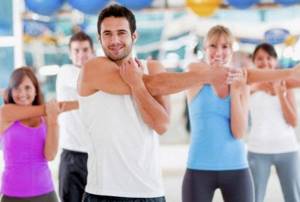
Just something complicated: Warm-up
Perhaps the best analogy there can be is that of an internal combustion engine. Tell me, what will happen to the engine if you start it and immediately give full throttle ? Well, maybe it will pass the first time, the 2nd time too, but the 3rd time, most likely, there will be sad consequences. So, by and large, the same thing happens to our body.
When our body is not warmed up and is in a calm state, it is very difficult for it to switch all systems into combat mode . Yes, of course, he will do this in stressful situations, but at what cost? As for training, we train 3-5 times a week, and some more. If every time you put extra loads without preparing it, then this will promise a bouquet of various ailments. So what is the main essence of the warm-up? What is she doing? Let's take a closer look now.
Universal exercises
Increasing muscle temperature start with basic relaxation. To do this, take the initial position – feet shoulder-width apart. Raise your arms as you take a deep breath and lower them as you exhale. And so 4-5 approaches.
Next, decide which muscle group is most loaded when stretching. These parts of the body should be the main focus when warming up. For any type of physical activity, there are such universal movements as neck rotation, shoulder warm-up, and torso rotations. To warm up the lower part, walk at a slow pace, squats, swing your legs, and jump rope. Bends forward give elasticity not only to the back muscles, but also to the vertebrae. A light jog is very effective. You can do it either on a treadmill in the gym or in the fresh air, which is healthier for the body. The calf muscles will become warmer as you lift your legs.
Stretching exercises can also serve as warm-up exercises. Raising your arms up, clasp your palm around the wrist of your other hand. Lean slowly to the left. Return to the original position and repeat, but in the opposite direction.
To warm up your lower muscles, lunge with one leg while resting on the knee of the other.
Gently pull the heel of the same foot towards the buttock with your hands
Lying on your back, lift your legs up at a right angle. Grasping your ankles with your hands, pull your legs towards your head, pulling your toes towards you. At the same time, do not lift your lower back off the floor.
The final exercises can be exercises with a skipping rope. If you don’t have one at hand, replace it with jumping on the spot.
So, regardless of whether you need stretching for professional victories, moral and physical satisfaction from body flexibility, or to benefit your body, you can achieve maximum results without associated injuries only by properly warming up the entire muscle group before stretching.
Necessary conditions for training at home
You need to do a warm-up at home in a well-ventilated area. There should be no stuffiness or stagnant air. You should not exercise in rooms where there are strong foreign odors. For example, a room that has recently been painted.
Clothing should be comfortable and not interfere with warming up. The same applies to shoes: it is better to choose suitable sports shoes, sneakers or sneakers. There should be no obstructive decorations that could get caught or scratched.
According to many athletes, warming up gives the greatest effect in the morning. But if you can’t exercise in the morning, this is not a reason not to exercise at all. By the way, it is useful to do a warm-up even on days when there are no workouts. This will invigorate the body and add tone for the whole day.
Before warming up and training, you should not eat for about an hour. But after training it will be useful to eat. You can drink if you really want to, but take small sips and little by little. There is no need to be distracted by extraneous things during classes, this will reduce efficiency. Good music can give you an extra boost of energy.
Warm-up before training at home for men
It doesn’t matter where the workout will take place, at home or in the gym, you need to warm up your body very well. The following warm-up complex is ideal for men:
- Head rotations - 30 times.
- Rotations of the knee joints - 20 times.
- Rotations of the hip joint - 20 times.
- Mill - 20 times on each side.
- Body turns - 20 times for one side.
- Torso bends - 20 repetitions for each side.
After doing these exercises, you need to give your body a cardio workout. The ideal option is a five-minute run or jumping rope. By the way, there is a very good exercise for warming up your entire body - burpees. Technique for its implementation:
- Take a lying position, as if doing push-ups.
- Bring your knees closer to your chest with a jump.
- From this position you need to jump and clap.
- Return to the starting position.
This exercise is the perfect way to complete your warm-up. First, your heart rate will be suitable for strength training. Secondly, absolutely all muscles will be warmed up. Well, it’s not even worth talking about the work of the respiratory system, because everything is already clear. Before performing it, you must complete the exercises that we have suggested for you.
Such a warm-up complex will minimize the risk of injury and make your training process more effective.
Types of warm-up
There are several common types of warm-ups, each of which will help the athlete specifically prepare the body for a heavier load.
General warm-up
The main goal of this type of warm-up is the smooth entry of the body into the exercise process. Do cardio work (athletes most often jump rope and jog). The general warm-up should take about 5-10 minutes.
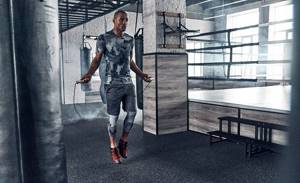
© gstockstudio — stock.adobe.com
Joint warm-up
This warm-up consists of simple exercises aimed at developing joints before class. During joint warm-up, the athlete alternately works and warms up all the joints of the body. The exercises must be performed one after another. The athlete works the neck, shoulders, elbows, wrists, lower back, pelvis, knees, ankles.

© Maksim Šmeljov — stock.adobe.com
Special (functional) warm-up
Athletes do this type of warm-up before specific exercises. You should specifically target only certain muscle groups. For example, if you need to bench press, then the first set is best done with an empty bar. Then the load increases a little, but if you have decent working weights, then immediately putting 100 kg after an empty bar will be wrong; you need 1-2 more warm-up approaches. This will be an example of a special warm-up.
The best way to warm up before a popular CrossFit exercise called jumping jacks is to do a little jumping rope. Thus, each athlete needs to do a couple of warm-up approaches in a specific exercise. They need to be completed before the main WOD workout. The number of repetitions per set should be minimal.
A set of exercises for warming up
Introductory warm-up exercise
Effect of the exercise: this movement completely works out the entire structure of the body. The hips, thighs, hamstrings and calves get a great stretch. In addition, ankle mobility, shoulder stability, and thoracic spine rotation are addressed.
Start with your feet hip-width apart and your arms raised high. Bend over with a straight back, place your palms on the floor and move your arms forward to a high plank position (or the starting position before push-ups from the floor). Bend the left leg at the knee joint and place the foot on the outside of the left arm. Rotate your left arm and rotate your chest upward, allowing your gaze to follow your arm.
Bring your left hand back and straighten your left leg, leaving your left hand on the floor. Keep your back straight as you stretch your left leg. We return the leg to the lower lunge (the leg on the outside of the arm) and after that we return the leg back, becoming again in the high plank position. Moving our hands back, we unbend and move to the starting position. We repeat the same movement on the other side.
Chest opening while lying down
The effect of the exercise: we stretch the chest tissue and activate the thoracic spine.
Lie face down with your arms extended in different directions at shoulder level or slightly lower. Engaging your abdominal muscles, shift your weight to your right side and lift your left leg, extending it to touch the floor behind your right leg. Allow your left hip to rise as your left arm rises and points straight at the ceiling. Do each rep for a count of 8: moving for a count of four and holding the end position for a count of four. After that, repeat on the other side.
Crossing the knees on the back
Exercise effect: improves lower body mobility.
We lie face up with our arms extended in different directions at shoulder level.
Please note that the shoulders should touch the floor as well as the palms with the inside should touch the floor for leverage. Bend your right leg at the knee and lift it up
Turn around and touch your knee to the floor behind your left leg. At the same time, make sure that your right shoulder does not leave the floor. Repeat the same with your left leg.
Reverse lunge with knee touching floor
The effect of the exercise: the iliopsoas muscle is stretched and the buttock muscles are activated.
Start with your feet hip-width apart and your hands on your hips. Step back with your left foot and move into a low lunge with your knee on the floor. In this position, rotate your hip inward (this is a small movement without changing the rest of your body). Raising your left knee, return to the starting position. Repeat with the other leg.
Alternating knee and ankle grips
Effect of the exercise: stretches the hip flexors and quadriceps, relaxes the gluteal muscles.
Starting position: standing, feet hip-width apart. Hug your left knee with both hands and press it to your chest for 2 counts. Repeat with the other leg. Bend your left leg back to touch your buttocks while grabbing your ankle with your left hand and pressing it against your left buttock. Raise your right hand up for balance. Focus on pointing your left knee straight down so that your hip and lumbar spine form a straight line. Repeat on the other side. Then repeat the entire sequence again.
Arm rotation with alternating hamstring stretches
The effect of the exercise: opens the chest, increases the mobility of the shoulder joint and stretches the hamstrings.
Feet hip-width apart, arms at your sides. Step forward with your left foot and bend your right leg. Pull the toe of your left foot up, left leg straight
Pay attention, your back is straight. Rotate your arms from below forward as far as possible with your body tilted forward
The arms rotate, rise up and spread to the sides. Switch legs, moving slowly and smoothly.
Now that the set of warm-up exercises has been completed, you can begin the main part of the workout.
Hitch
Cooling down is doing certain exercises after training. These exercises will help you calm down and relax. And also speed up the recovery of your muscles after hard work. For both men and women, the ideal cool-down option is a simple set of stretching exercises:
- Rader row is an exercise for stretching the back and pectoral muscles. It is done extremely simply. Your task is to find some support and place your hands on it. Next, you need to tilt your torso down and leave your arms on the support. This will help stretch your chest and back as much as possible.
- Hanging on a horizontal bar is a very useful exercise for restoring normal functioning of the spine. After performing basic exercises such as squats and deadlifts, the spine becomes slightly compressed. To fix this, you need to stretch it. This exercise is one of the best for stretching the spine.
- Forward bends will help you stretch your hamstrings and hamstrings. An indispensable exercise after leg training.
- Butterfly is an exercise for stretching the adductor muscles of the thigh. Your task is to touch the soles of your feet to each other and hold them with your hands. After which, begin to stretch your knees down.
- Back arches are also very useful for spinal recovery after basic exercises. Your task is to arch your back while lying on your stomach. You need to focus on lifting your torso.
- Abdominal stretching on a fitball is a very enjoyable post-workout exercise. It’s especially pleasant to do it if you pumped up your abs yesterday, but today they ache. There is a fitball in every gym. And if you are working out at home, then you can lie on the sofa and stretch your torso down. The main thing is to have someone hold your feet.
Gymnastic stretching
In order to get all possible efficiency from stretching, two blocks are used - static and dynamic. When performing static exercises, the body freezes in a certain position and does not make movements. Static exercises are done in motion; gymnasts do both slow and fast movements with different amplitudes. For a dynamic block, rolls from twine to twine and swings are used. Towards the end of the stretch, splits are done.
It is very important to spend enough time on both legs, stretch the back of the thigh well, and do both longitudinal and transverse splits. The cross split must be correct; performing it incorrectly with the hips turned out will not do any good, but harm.
Stretching can be active, when the gymnast stretches herself and uses only her own body weight, or passive, when the coach puts pressure on her.
For stretching, use splits, different types of lunges, butterfly and frog exercises. Warm-up includes many bends and waves in different directions, back and forth, rolls and bridges are required, they are necessary for the back. Leg holds are always included in the warm-up, this increases the range of movements.
A set of dynamic warm-up exercises to prepare for training 2
Running time: 5 minutes
The biggest mistake in training is not doing a warm-up. Everyone needs it, regardless of their goals: build muscle, lose weight, keep yourself in good shape, etc. Below we'll show you how to warm up before running or strength training using dynamic movements that will help you warm up properly and avoid injury.
Equipment: not required
Suitable for developing strength, flexibility of muscles and ligaments, joint mobility when performing movements.
Instructions: Complete the indicated number of repetitions for each movement and move from one exercise to the next, without stopping to warm up and begin to exercise the entire body muscles.
Hamstring stretch
Technique: Start in a kneeling position with one knee bent and your foot flat on the ground in front of you; Bend your back knee and place it behind you. Both elbows will form 90 degree angles. Start by rocking back and forth, bending deeper at the front knee. Do this five to six times. Then move your front leg at a right angle from your body and repeat the movement. Move your front leg away from your body and repeat. Then move your leg diagonally. Perform the same movement on the opposite side. This is one repetition.
Stretching the hamstrings and inner thighs
Technique: Start on all fours. Extend your right leg to the side. Push your hips back until your butt touches your left leg, then walk your hips forward until your body forms a straight line from head to knee. This is 1 repetition.
Do 10 reps on each side.
Warm up the hip joint
Technique: Start on all fours. Bring your left knee toward the floor. In a controlled manner, circle it from your left elbow, then up and out to the side at hip level, then back until your quadriceps is parallel to the floor.
Perform 10 repetitions on each leg.
Shoulder stretch
Start the technique on all fours. Slide your right hand along the floor behind your left wrist until your shoulder rests on the floor. Reverse the movement and raise your right arm into the air, turning your head to look up.
Do 10 reps.
Full body stretch
Execution technique: first stand, and then begin to lower yourself to the plank position on your hands. Raise your right leg, extend it behind your hand, and lunge. Touch your right elbow. Rotate your torso to the right and raise your right arm into the air. Return to the starting position.
Complete 10 reps.
Side Lunges with Knee Raise
Technique: Start in a standing position. Step sideways with your right foot, push your hips back, and lower your body until your leg is bent 90 degrees. Shift your weight to your left leg. Return to the starting point. This is one repetition.
Do 10 reps on each leg.
Why you need to warm up
The purpose of the warm-up is to prepare the athlete for the upcoming loads. It affects the body as follows:
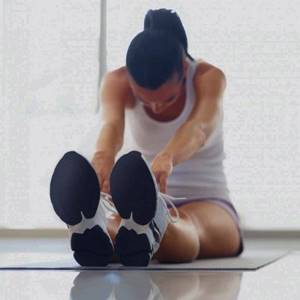
- It prepares the nervous system for intensive work, allows for more accurate and coordinated actions in the upcoming training, and improves a person’s ability to learn new movements and exercises.
- Metabolism accelerates, which allows muscles to receive the energy they need to work.
- The work of the circulatory and respiratory systems is activated, as a result of which oxygenated blood will flow to the muscles in sufficient quantities.
- Stretching muscles before training increases their elasticity - this helps to avoid injury.
- Joint warm-up promotes the release of additional synovial fluid, as a result of which all movements will occur smoothly and without crunching, and the cartilage will not be damaged during training.
- The head is freed from unnecessary thoughts, the person tunes in and concentrates on the training process.

